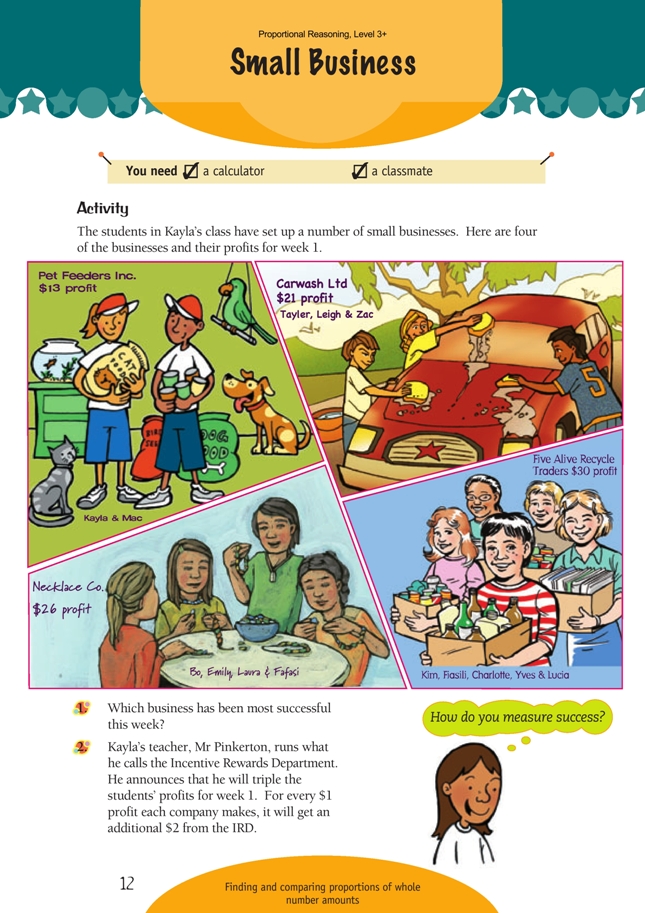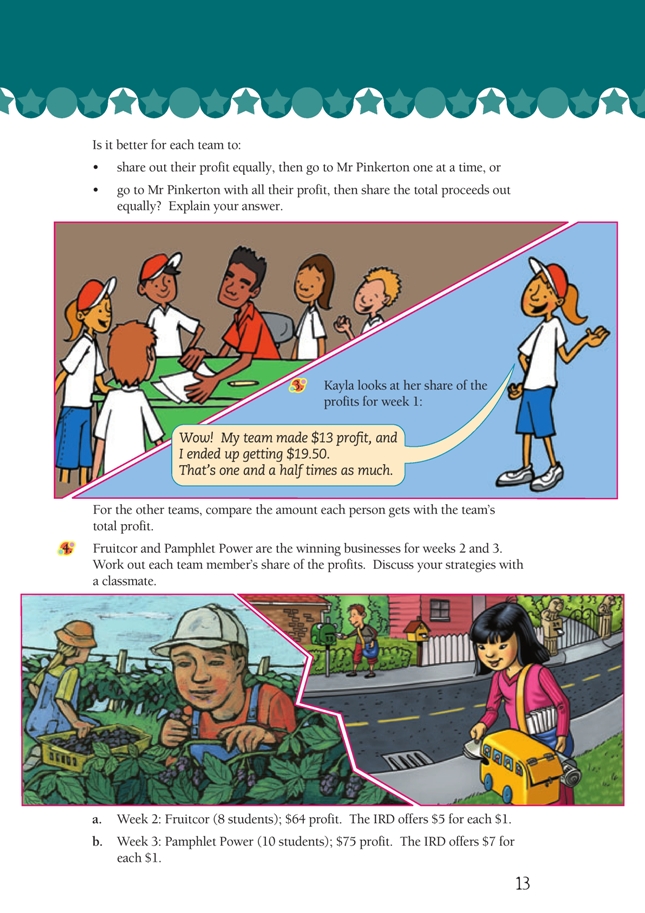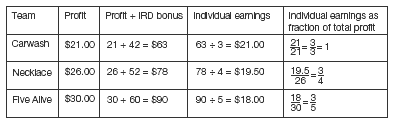This is a level 4 number activity from the Figure It Out series. It relates to Stage 7 of the Number Framework.
A PDF of the student activity is included.
Click on the image to enlarge it. Click again to close. Download PDF (1318 KB)
compare proportions
Number Framework Links:
Use this activity to help students
• consolidate their knowledge of basic facts (stage 6)
• consolidate and apply their knowledge of fractions (stages 6 and 7)
• develop their ideas about proportion (stage 7).
FIO, Level 3+, Proportional Reasoning, pages 12-13
A classmate
Using this imaginative (and unlikely!) business scenario, students explore the difference between group and individual profit and calculate and compare different profits.
Before they get far with question 1, they need to address the question posed by the thought bubble: “How do you measure success?” It is clear that the Five Alive group had the largest group profit ($4 more than any of the other three teams), but when the $30 is shared between the 5 members of the team, this amounts to $6 each, which is less than the $7 per person earned by the members of the Carwash Ltd team. So if success is the profit earned by the individual members of the team, Carwash Ltd is most successful. Students are likely to see the second measure of success as the
most valid one.
Question 2 is about order: does it make a difference whether we divide and then multiply or multiply and then divide? Students will find that no matter which of the four sets of results they use, they get the same answer regardless of the order of the operations. For example, Five Alive:
• Option 1: Each person gets 30 ÷ 5 = $6; when tripled by the 2-for-1 offer, this becomes 6 x 3 = $18.
• Option 2: The group profit, once tripled by the 2-for-1 offer, is 30 x 3 = 90; when shared between 5 people, this becomes 90 ÷ 5 = $18.
You could discuss with your students whether showing that this is true for one group is enough to prove that it is always true. (It’s not. They could have a rogue result. They should check the figures for the other three groups for a greater degree of certainty.)
Question 3 asks students to look at the amount each person receives (including the bonus) and compare this with the original profit for the whole team. The result in each case is best expressed by a fraction. If the four fractions are left as improper fractions, an interesting pattern can be seen: 3/2, 3/3, 3/4, 3/5. You could challenge your students to think about why this pattern occurs. The reasons are these: the top number says that the profit has been tripled; the bottom number says that it is shared among that number of people. So the fraction is independent of the dollar value of the
profit: if the profit is doubled and there are 7 people to share it, the fraction is 2/7.
Students should share the strategies they use to answer question 4. Here are three possibilities for question 4a:
1. Each person earns 64 ÷ 8 = $8 profit. In addition to this, they get 5 x 8 = $40 from the IRD, making a total of $48.
2. Each person earns 64 ÷ 8 = $8 profit. In addition to this, the team gets 5 x 64 = $320 from the IRD. Each person gets of this bonus ($40), making a total of 8 + 40 = $48.
3. The team’s total profit including the bonus from the IRD is 64 x 6 = $384. This needs to be split between the 8 team members, giving 384 ÷ 8 = 48. (8 x 50 = 400.
400 less (8 x 2) = $384. So 384 ÷ 8 = 50 – 2 = $48. [Rounding and compensating]).
Similar strategies can be used to solve question 4b.
Answers to Activity
1. As far as total profit goes, Five Alive is most successful. ($30 is $4 better than the next highest profit of $26.)
On a profit-per-student basis, Carwash Ltd is the most successful. Each student earns $7. (21 ÷ 3 = $7.00)
2. The order in which students do things makes no difference to the share that each gets. For example, for Necklace Co:
• Share out first, then go to Mr Pinkerton:
26 ÷ 4 = $6.50 → $6.50 x 3 = $19.50.
• Go to Mr Pinkerton first, then share out:
26 x 3 = $78 → $78 ÷ 4 = $19.50.
3.
4. a. $48. Strategies will vary. Each person gets a 1/8 share of the $64 profit ($8) plus 1/8 of the $320 (5 x 64) from the IRD, which is $40.
b. $60. Strategies will vary. Each person gets a 1/10 share of the $75 profit ($7.50) plus 1/10 of the $525 (7 x 75) from the IRD, which is $52.50.


